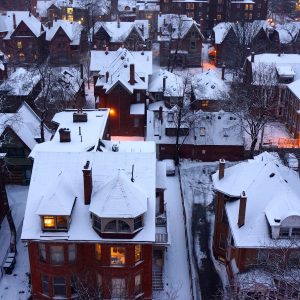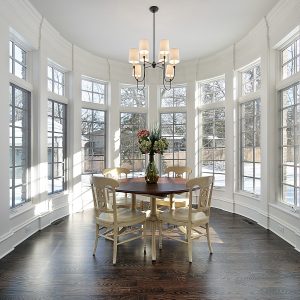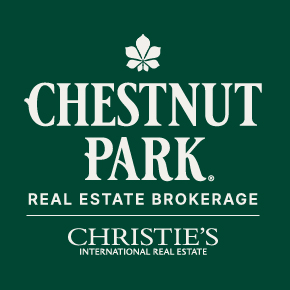There are thousands of available homes on MLS that may be perfect for you! Include your name and email address below to receive your custom list of new available homes in your desired neighbourhoods each morning. You will often receive new listings before they appear on other sites such as REALTOR.ca, giving you a head start with your search.

For the second month, the Toronto and area market place produced double-digit increases compared to the same month last year. In May 9,989 residential properties were reported sold in the greater Toronto area, a stunning 19 percent increase compared to the 8,402 that sold in 2018. The recovery of the Toronto housing market is due to a number of factors. The mortgage stress testing rules introduced in January 2018 appear to have been absorbed by buyers. More resale properties have come to market, although still not enough to create a balanced market. And lastly, interest rates have edged downward, softening the impact of the new mortgage stress testing.
It comes as no surprise that with the increase in the number of sales, average sale prices have also continued their upward momentum, although not as dramatically as the number of reported sales. In May the average sale price came in at $838,540, 3.6 percent stronger than the $809,305 average sale price achieved last year.
In the City of Toronto, average sale prices were even stronger. The average sale price for all properties sold in the City of Toronto came in at $937,804, 12 percent higher than the greater Toronto average sale price. This is a particularly startling number when it is remembered that it includes condominium apartment sales, the bulk of which are located in the City of Toronto. Almost 70 percent of all condominium apartment sales take place in Toronto (416 region). They continue to be the least expensive housing form available to buyers, although “least expensive” is becoming a relative term.
The increase in the average sale price was driven by an increase in the number of expensive homes that sold in May. This month 293 properties having a sale price of $2 Million or more were reported sold. That compares favourably with the 243 that were sold in 2018, a 20 percent increase. Over the past two years, higher-end sales have been relatively dormant.
In May 19,386 new property listings came to market, an almost identical number to the 19,237 that came to market last year. Unfortunately, the new listings that came to market were insufficient to effectively increase the supply. At the end of May, there were 20,017 properties available to buyers in the greater Toronto area, almost 5 percent less than were available at the same time last year. As the resale market moved into June there were 2.5 months of inventory in the 905 and only 2 months of inventory in the City of Toronto.
Not only did more properties sell in May with rising prices, but all sales took place at lightning speed. All properties sold (on average) in only 19 days. Depending on the type of property and location, the speed of sales was even faster. For example, semi-detached properties in Toronto’s central core sold in only 14 days. In Toronto’s eastern districts they sold in only 10 days, at 106 and 109 percent over the asking price, respectively. Generally, it took much longer for properties to sell in the 905 region, ranging from 25 days in the Halton region to 36 days in Simcoe County. Sale in the York region took 27 days.
In May 2,542 condominium apartments were reported sold, almost 70 percent of them were located in the City of Toronto. The average sale price for all condominium apartments sold was $648,891. In Toronto’s central core, where 63 percent of all reported sales were located, the average sale price came in at an eye-popping $718,455. What may be even more startling is that all these condominium apartments sold in only 17 days and at 100 percent of their asking prices.
Notwithstanding that condominium apartments are now becoming quite pricey, the supply still remains insufficient to meet demand. At the beginning of June there were only 2,568 condominium apartments available to buyers, more or less the same number as were available last year when the average sale price was $40,000 less than it is this year. To qualify for an average priced condominium apartment in Toronto’s central core now requires a household income of substantially more than $100,000 annually and a 10 percent down payment of more than $70,000.
Looking ahead to June we can anticipate that sales will probably decline from May’s torrid pace to a more moderate 9000 sales, with the average sale price increasing moderately by about 3 percent. Price increases in this modest range are exactly what the Toronto resale market needs in order to remain sustainable.
Prepared by Chris Kapches, LLB, President and CEO, Broker, Chestnut Park® Real Estate Limited, Brokerage.
Have questions about the market or selling or buying?
Contact me any time. I’m happy to answer any questions you may have.

April’s housing market results clearly demonstrated that the Toronto and area resale market is strong and robust. As indicated in previous monthly reports, any sluggish behaviour by the resale market was due to a lack of inventory, and not to a decline in buyer demand.
In April, for the first time in several months, the number of new listings coming to market exceeded expectations. No doubt improved weather conditions were a major factor. In April 2017, 205 new properties came to market, 8 percent more than the 15,933 that came to market in April last year. For the first time in many months, buyers had a choice that had previously been unavailable to them. Notwithstanding this increase in new listings, by month-end, the total number of active listings available to buyers was only 18, 037 properties, still 1 percent less than the 18,206 available last year. The explanation? Absorption.
April saw Toronto and area realtors posting 9,042 sales, a dramatic 17 percent increase compared to the 7,744 properties that were reported sold last year. It is obvious that buyers were waiting for more properties to become available. They did, however, have to act extremely quickly.
In April all properties sold (on average) in only 19 days, an astounding number when it is considered that this number represents the sale of all properties in the greater Toronto area, including condominium apartments. In some neighbourhoods, the pace of sales was even faster. For example, all semi-detached properties in the neighbourhoods of Riverdale, Leslieville and the Beaches sold in only 8 days, a pace not seen since the frenzied period leading up to April 2017. In fact, all semi-detached properties throughout the entire 416 area of Toronto sold in only 10 days, and for average sale prices of 107 percent over asking.
Condominium apartment sales were just as resilient. All condominium apartment sales in the City of Toronto took place in only 17 days and for average sale prices of 100 percent of the asking price. This was also true in Toronto’s central districts were more than 60 percent of all Toronto condominium apartment sales are recorded. What is a troubling about these results is that for the first time the average sale price in the central core exceeded $700,000. The once affordable alternative housing is now becoming quite pricey in Toronto.
With sales happening at these speeds throughout the greater Toronto area, it is not surprising that the average sale price also increased In April. The greater Toronto average sale price came in at $820,148, almost 2 percent higher than last April’s average sale price of $804, 926. In the City of Toronto, the average sale price was even higher, coming in at $904,000, once again a number similar to the one that caused the provincial government to implement various measures to try to cool the resale market, including the implementation of 15 percent foreign buyer’s tax. It should be added that that number includes condominium apartment sales, which account for 50 percent of all reported sales. If condominium apartments are removed for this calculation the average sale price for detached and semi-detached property sales in the City of Toronto comes in at $1,193,000.
In April we saw some improvement in the number of higher-end sales. April saw 250 reported sales having a sale price of $2 Million or more. This compares favourably with the 233 that were reported sold last year, a 7 percent increase. These numbers were one of the first increases recorded in this price-point in some time. Although most of these sales were represented by detached properties, it is worth noting that almost 10 percent of the sales reported in this price-point were condominium apartments. Only 8 of these $2 Million or more reported sales were semi-detached properties.
It is clear from April’s data that the resale market has recovered in the City of Toronto but continues to lag in the 905 regions of the greater Toronto area. In the 905 regions sales took place at a slower pace, and average sale prices are substantially lower. As indicated earlier, the average sale price for all properties sold in the City of Toronto came in at $904,000, including condominium apartments. In the 905 region, the average sale price was only $820,000, almost 10 percent lower. Similarly, all sales in the City of Toronto took place in only 17 days and at 101 percent of asking prices. In the 905 regions sales took 19 days and at only 99 percent of asking prices. As April came to an end the 905 regions had 2.6 months of inventory, whereas the City of Toronto was reduced to only 2 months of inventory.
The looming concern in all this good news is affordability. It is exciting and invigorating to see how resilient the greater Toronto area resale housing market is, however with average sale prices approaching $1 Million in Toronto and $820,000 in the 905 regions, buying a property in the greater Toronto area may soon be beyond the reach of most first-time buyers.
Prepared by Chris Kapches, LLB, President and CEO, Broker, Chestnut Park® Real Estate Limited, Brokerage.
Have questions about the market or selling or buying?
Contact me any time. I’m happy to answer any questions you may have.

TREB’s March results reaffirm a predicted shift in the discussion around Toronto’s real estate market. We are no longer talking about a dramatic year over year growth, but rather about the lack of supply and affordability issues from first-time buyers. The intervention of government on both a federal and soon-to-be municipal level may incite more buyers and sellers to enter into the upcoming spring market. This, in turn, may encourage more listings and more sales. This intervention, however, may not impact affordability as such intervention will increase buyer competition, while not dramatically increasing Toronto’s housing supply. The lack of inventory and the affordability issue will not be resolved until Toronto finds creative ways to cut through the bureaucratic red-tape and time delays to add more new homes.
March 2019’s marginally lower sales growth, as compared to the last three years, was due to a lack of supply in all markets. This slower growth, however, shouldn’t be overstated as the sales difference between 2018 and 2019 were negligible – March 2018 saw 7,188 sales while 2019 saw 7,187 sales. We also saw sales increase in March from February’s disappointing 5025 sales. Since we saw sales grow in January and then slow down in February (likely due to weather conditions and not a weakening market), it’s difficult to predict if sales will outpace 2018. Nonetheless, even if sales do slow, it does not necessarily indicate a weakening Toronto real estate market.
Demand for Toronto housing remains high for solid reasons. Our relatively open immigration policy, coupled with our international status as one of the best places to headquarter a technology company, continues to stimulate long-term interest in Toronto’s real estate market. This is evidenced by the fact that both the housing price index (HPI) and the average sale price still remains higher than last year. Toronto properties, including condominiums, sold for an average of $830,043 in comparison to $817,642 in March of last year. It’s important to note that, while March’s average sale price wasn’t higher than February’s sale price of $840,000, this price decline is likely a short term rather than a long-term trend. This conclusion is drawn because the HPI – a more reliable metric that smooths out the swings associated with averages – rose by 5.55% year over year for all housing types in Toronto. Accordingly, today’s prices are a lasting change in buyer’s willingness to pay to work, live and play in Toronto.
The continued price growth in Toronto was not mirrored in the rest of the regions under TREB. For example, while the HPI for the York Region declined by -1.95%, the Peel Region HPI grew by 5.01%. Nonetheless, the overall HPI for “non-Toronto-core” markets declined by -1.46%. Comparing this spotty growth with Toronto’s HPI loosely suggests that Toronto may not be completely inflated by cheap money and foreign buyers, but rather Toronto is a destination for both highly skilled workers and companies to plant their flags.
Two other metrics used to measure market conditions are days on market (DOM) and months of inventory (MOI). While the former metric is not perfect because it can be skewed by relisting a property, it is still useful in understanding how quickly real estate is moving. And it is. In Toronto, all property types sold at a relatively quick pace of 19 days. While this number is not as shocking as the 15 days it took in March 2018 to sell a property, it is still impressive when compared to other desirable markets. New York City regularly sees properties sit for almost 100 days and San Francisco sees homes sit close to 40. What is more, the MOI for all properties in Toronto remains very low at 2.0, confirming that Toronto is still in a seller’s market.
As addressed in our February 2019 Market Report, the last truly affordable housing type, condominium apartments, continued on the path of unaffordability. Condominiums in central Toronto, the place where demand remains highest, sold for an average of $673,330. This is still much lower, however than the $2,009,104 average commanded by detached homes in the same area. Given this staggering number, the activity in the mid-priced condominium market may be fuelled by necessity rather than by choice of lifestyle.
Even though the high-end property market has fewer buyers, sales continued to grow. In March 2019, 139 properties with a sale price of $2 Million or more across all TREB regions were sold. This is an improvement over the 118 sales from last month. An interesting trend in 2019 is that almost 10% of homes sold in the luxury market are condos, as opposed to detached or attached homes. The reason for condo purchases in the luxury market, however, is markedly different than the reason for condo purchases in the mid-market. High-end buyers, unlike mid-market buyers, are choosing condos because of lifestyle and not because of necessity.
As we move into the spring market, we anticipate more properties coming to Toronto’s market. These properties, however, may still be out of reach for mid-market buyers looking to live in the Toronto core. While continued low interest rates coupled with the federal government’s housing assistance plan may encourage buyers to become active in the market, this support will not be enough to improve Toronto’s affordability, thereby forcing most buyers to look to the more “depressed” 905 regions and causing a slow-down in Toronto’s year over year price growth.
Prepared by Chris Kapches, LLB, President and CEO, Broker, Chestnut Park® Real Estate Limited, Brokerage.
Have questions about the market or selling or buying?
Contact me any time. I’m happy to answer any questions you may have.

February results were expected to continue what we saw in the first month of 2019 — modest growth in sales and average sale prices. That didn’t materialize. I have generally not regarded the weather as having a material impact on the residential resale market, but this February may be the exception.
This February we saw a modest decline in sales compared to February last year. This year 5,025 properties were reported sold, a small decline of 2.4 percent compared to the 5,148 properties reported sold in February 2018. The reason for this decline, particularly in the 416 regions, was simply due to a lack of inventory. Since January saw a year-over-year increase in supply, the only plausible explanation is the weather. February brought three major snow storms, and effectively paralyzing the greater Toronto area on three different occasions, with snow mounting to shocking levels. It is not surprising that properties did not come to the market.
In February only 9,828 properties came to market, 6 percent less compared to the 10,473 that became available least year. Even the 10,473 properties that became available last year were insufficient to meet demand. Consequently, as we enter March, we are marginally lower than the properties available to buyers last year, and most of the properties are in the 905 regions of the greater Toronto area. Of the 13,284 properties available for sale, 70 percent of them, or 9,352, are located in the 905 regions.
It is clear that demand is present and because of supply shortages it is beginning to pent up. In February the properties that sold caused the average sale price to increase for the second month in a row. All properties sold for $780,000 in February, almost 2 percent higher then last February’s sale price of $767,000.
In the City of Toronto, the average sale price increased dramatically to $840,000 (a price which includes all condominium apartment sales), at least 10 percent more than the average sale price in the 905 regions. The clearest example of both the supply shortages and the impact on average sale prices is February’s average sale price for semi-detached property in the City of Toronto. In February the average sale price came in at a shocking $1,087,363. Semi-detached property sales only exceeded $1 Million during the frenetic increase in prices in late 2016 and the early months of 2017.
The length of time that properties spent on the market also demonstrates how strong the City of Toronto’s resale market continues to be. In February all properties available for sale in the greater Toronto marketplace sold in only 25 days. In the City of Toronto sales happened at a lightning speed of 22 days. Semi-Detached properties both in the 905 regions and the City of Toronto sold even faster – 18 and 15 days, respectively. What is astounding and further proof that supply is insufficient to meet demand, is that all semi-detached properties sold for more than their asking price. At 102 percent in the 905 regions and at 106 percent in the City of Toronto.
It is concerning that the last truly affordable housing type, condominium apartments, is rapidly becoming unaffordable. In February all condominium apartments sold in the City of Toronto (on average) for $612,000. In Toronto’s central districts, where most condominium apartment sales take place, the average sale price came dangerously close to $700,000. With the increase in mortgage interest rates and the implementation of mortgage stress testing, these prices are making it very difficult for first time buyers to enter Toronto’s real estate market.
At the other end of the real estate spectrum, higher end property sales continue to strengthen. In February 118 properties having a sale price of $2 Million or more were reported sold. This compares favorably to the 126 sold last year. It is interesting to note that condominium apartments accounted for almost 10 percent of sales in this price category.
As we move into March and improving weather conditions, we anticipate more properties coming to the market to meet demand. It would appear that buyers have accepted higher interest rates and mortgage stress testing but are frustrated by their inability to find suitable properties for sale, especially semi-detached properties in the City of Toronto.
Prepared by Chris Kapches, LLB, President and CEO, Broker, Chestnut Park® Real Estate Limited, Brokerage.
Have questions about the market or selling or buying?
Contact me any time. I’m happy to answer any questions you may have.

2019 started positively, surprising many who were anticipating the double-digit declines that the Toronto and area residential resale marketplace delivered in November and December of last year. Although moderate, January delivered increased sales volume and average sale prices compared to January 2018.
There were 4,009 sales reported in January, a less than 1 percent increase compared to 2018, but an increase nonetheless. Encouragingly, January’s positive results were due to an improvement in Toronto’s 905 region. The Greater Toronto Area was dramatically impacted by the provincial foreign buyers’ tax and has lagged behind the Toronto 416 market since the spring of 2017. In January, the 905 region’s sales were up by 2.5 percent compared to last year, while the City of Toronto’s sales declined by 3.5 percent. The decline in City of Toronto sales was not caused by a decline in demand. Rather the decline was driven by a chronic shortage of supply. At the end of January, the Greater Toronto Area had 2.7 months of inventory, whereas the City of Toronto found itself with only 1.9 months of inventory. The difference in inventory is also reflected by the fact that sales in the 905 region took place in 33 days (an average), yet it took only 29 days for all properties in the City of Toronto to sell.
Another positive aspect of January’s performance is the supply of new properties that came to market. In January, 9,456 new properties became available to buyers. This is a favourable 10.5 percent increase compared to the 8,561 new listings that became available last year. Entering February, active listings were slightly higher than last year. February began with 11,962 active listings compared to the 11,894 available last year. The bulk of these listings are located in the 905 region. OF the 11,962 active listings, 8,387, or more than 70 percent, are located in the 905 region.
January’s average sale price came in at $748,328, an increase of almost 2 percent compared to last year’s average sale price of $735,874. This is exactly the kind of increase that reflects a stable and sound market, not the double-digit monthly increases that became commonplace in 2016 and early 2017. Double-digit increases in average sale prices become unsustainable and unfortunately can lead to painful corrections.
In this regard, Toronto’s high-end residential market continues to adjust. In January, 76 properties having a sale price of $2 million or more were reported sold. This compared to 90 reported sold during the same period last year. The adjustment is also evident in the sale price to listing ratio witnessed in January. Detached properties in Toronto’s central districts are the most expensive properties in the Greater Toronto Area. All detached properties in these districts sold for 95 percent of their asking price. This ratio was much lower than the detached properties in other trading districts. For example, all detached properties in Toronto’s eastern districts sold for 100 percent of their asking price. The fact that the average sale price in the eastern districts is half ($916,588) that of the central districts ($1,938,617) is no doubt responsible for this divergence. Higher-end properties accelerated more dramatically during the pre-2017 introduction of the Ontario Fair Housing Plan and are retracting proportionally, especially with the introduction of the 15 percent foreign buyers’ tax.
Condominium apartments continue to be the most affordable housing form, but again, because of supply, average prices continue to increase. In January, the average sale price in the City of Toronto increased by almost 9 percent to $591,444. In Toronto’s central districts, where most condominium apartment sales are located, the average sale price came in at $677,997, a 10 percent increase compared to last year’s prices. In January, there were only 1,738 condominium apartments for sale in the City of Toronto and only 1,093 in Toronto’s central districts where most sales take place. This shortage of supply will continue to put upward pressure on prices, constrained only by affordability.
Although it is a little early in the year to be forecasting for 2019, January’s results – sales volumes, price increases and increases in supply – all point to a healthy 2019. Last year only 77,375 residential properties were reported sold, the lowest number since the recession of 2008. Barring any unexpected economic events this year, we should see between 83,000 and 85,000 reported sales, with average sale prices increasing by about 2-3 percent. January’s average sale price came in at $748,328. Last year’s annual average sale price was $787,000. By year-end, Toronto and area’s average sale price should be approximately $800,000. From a long-term sustainability prospect, we should be thrilled with this number.
Prepared by Chris Kapches, LLB, President and CEO, Broker, Chestnut Park® Real Estate Limited, Brokerage.
Have questions about the market or selling or buying?
Contact me any time. I’m happy to answer any questions you may have.

There were no surprises in December. The year came to an end as expected. Higher borrowing costs and the new stress testing measures implemented at the beginning of the year are now a driving force in the Toronto housing landscape. The landscape is now one of moderating sales volumes and average sale prices, as was made evident in December’s resale data.
In December sales declined by more than 22 percent compared to last year. Last December 4,876 properties were reported sold by Toronto and area realtors. This year that number shrank to 3,781, the lowest number of December sales since the 2008 recession. December’s sales brought total sales for 2018 to 77,426, a decline of 16 percent from the 92,000 plus sales recorded in 2017, and more than 30 percent fewer than the 113,000 sales reported in 2016. In 2016 mortgage interest rates were half of what they are today, and borrowers did not have to qualify subject to rigid stress testing rules.
In December the average sale price for all properties reported sold in the greater Toronto area held up well, coming in at $750,180, 2.1 percent higher than the $734,847 average sale price achieved last December. On an annualized basis, however, Toronto’s average sale price declined by slightly more than 4 percent, from $822,000 last year to $787,000 in 2018.
The decline in overall average sale prices was driven primarily by the decline in sales and sale prices for Toronto and area’s more expensive properties. In December only 82 properties having a sale price of $2 Million or more were reported. Last December 116 were reported sold. In December 2016, 140 properties were reported sold in this price category. On a year-to-date basis, 2,077 $2 Million plus properties were reported sold. In 2017, 3,435 properties in this price category changed hands, an eye-popping 40 percent decline. It should be noted that the bulk of these sales took place in the first 4 months of the year before the Ontario Fair Housing Plan and increased interest rates took effect.
Notwithstanding these negative figures, the landscape for resale housing remains fractured. It could be argued that these negative numbers are due not only to higher borrowing costs and the stress testing measures but to a lack of supply. In December only 4,308 new listings came to market. Last December 6,289 new listings came to market, a decline of over 30 percent. Heading into 2019 there were only 11,431 properties in the greater Toronto area available for buyers, a decline of more than 11 percent compared to the almost 13,000 available properties last year at this time. Most of the available properties are located in the 905 regions of the greater Toronto area. In the City of Toronto, there are only 3,270 properties available to buyers. In fact, 72 percent of all available inventory is located in the 905 regions.
These inventory levels mean that there will be neighbourhoods, particularity in the City of Toronto, where demand far outstrips supply. This was evident in Toronto’s eastern neighbourhoods, (Riverdale, Leslieville, Beaches), were even in December all properties reported sold generated sale prices exceeding their asking price by more than 100 percent. Semi-detached properties in these neighbourhoods sold for more than 105 percent of their asking prices, and in just 11 days or faster.
The inventory shortage can be dramatically illustrated by looking at detached and semi-detached properties available for sale in the City of Toronto. At the end of December, only 377 new detached properties came to market, not many more than the 340 that sold in the month. The situation for semi-detached properties is even more severe. At the beginning of this year, there were only 154 active listings in the entire City of Toronto, only 38 more properties than the 116 semi-detached properties that sold in December. The situation for condominium apartments parallels the shortage of semi-detached properties.
These property shortages would normally result in substantial price appreciation. Normal however is no longer 2.5 percent five-year fixed mortgage interest rates. Bank posted rates are currently 5.59 percent, and even if that isn’t the rate borrowers will have to pay, the buyers will, because of stress testing, be required to qualify at that rate. The disappearance of cheap and easy money is now driving the Toronto and area market place.
Looking forward, certainly, in the short term, there is nothing on the horizon that will see any dramatic changes to the current Toronto real estate market. Sales volumes will be lower than historic norms, and average prices will continue to moderate. Currently, unemployment numbers are at a 40-year low. Subject to stability in the mortgage markets, wages should start to rise beyond inflationary levels which with time will ease our prevailing affordability problems, which in turn should see moderate increases in sales volumes and to some extent in average sale prices. The process will be slow with both buyers and sellers at times adjusting painfully to the new resale landscape.
Prepared by Chris Kapches, LLB, President and CEO, Broker, Chestnut Park® Real Estate Limited, Brokerage.
Have questions about the market or selling or buying?
Contact me any time. I’m happy to answer any questions you may have.

It was no surprise that the Toronto and area residential resale market retracted in November. Sales volumes were off by 14.7 percent compared to reported sales last year. This November 6,251 properties were reported sold compared to 7,326 in 2017. There are many factors responsible for the current market. In fact, there are two markets: the city of Toronto (or the 416 region) and the 905 region which includes Halton, Peel, York, Durham, Dufferin, and Simcoe County.
Overall the market is now feeling the impact of the Office of the Superintendent of Financial Institutions mandated stress testing which came into play in January, and the various increases in borrowing costs. The combination of these measures has had a direct impact on affordability. The days of buyers paying indiscriminate prices are gone. Under these conditions, both sales and average sale prices will increase only moderately going forward.
By historical standards the market is still strong and depending on location and housing type, still a seller’s market. In the City of Toronto, detached properties saw the average sale price increase by 1.8 percent to $1,301,382; semi-detached properties increased by an eye-popping 17.2 percent to $1,060,359; and condominium apartments came in at almost $600,000, a year-over-year increase of over 7 percent. Average sale prices in the 905 region are not as robust. The average sale price for detached properties was only $905,517, $688,504 for semi-detached properties, and $454,288 for condominium apartments.
The market’s lack of inventory is becoming a serious concern. Fewer properties have been coming to market over the past several months, but the decline was very evident in November. Toronto and area realtors only delivered 10,534 new listings. By comparison, 14,150 new properties came to market last year, a decline of more than 26 percent. This decline has had a substantial impact on the total active listings available to buyers. At the beginning of December, there were 16,420 properties available for sale throughout the greater Toronto area, a decline of almost 10 percent compared to the 18,197-available last year.
Within certain neighbourhoods and trading areas, the lack of inventory has reached crisis proportions. In the City of Toronto there are only 283 semi-detached properties available for sale. In November 209 semi-detached properties were reported sold. This translates into just slightly more than one month of available inventory. In Toronto’s eastern districts the number of sales in November of this housing type exceeded the number of properties available in December. It is not surprising, therefore, that all semi-detached properties in the eastern districts sold at 107 percent of their asking prices and in 15 days, as compared to the 27 days it took for all properties to sell in the greater Toronto area.
Toronto’s condominium apartment inventory is also down to crisis levels. Considering that condominium apartment are Toronto’s only “affordable” housing stock, the dearth of condominiums apartment listings is particularly concerning. Only 1,928 new listings came to market in November. Last year 2,277 condominium apartments came to market. At month-end available inventory was reduced to only 2,167 active listings —— last year there were 2,355. This lack of product has caused the average sale price for condominium apartments to increase to $595,678, and in Toronto’s central core, where most sales take place, the average sale price was almost $670,000. Paying $1,000 per square foot for condominium resale apartments (on average) is now commonplace.
Pressured by the new mortgage stress testing rules and numerous mortgage interest rate hikes, Toronto and area high-end property sales continue to lag. In November 187 properties having a sale price of $2 Million or more were reported sold. Last year 203 property sales were reported in this category. When money was cheap, and money was easily available, high-end property sales accelerated dramatically to unsustainable price levels. Over the first six months of 2019 prices of properties in this price point will moderate and then begin to rise consistent with overall market increases in the second half of the year.
It is a safe calculation that total residential resales for 2018 for the greater Toronto area will come in at about 78,000 properties. By comparison, last year 92,263 properties were reported sold, most of them during the first half of the year, before the implementation of the Ontario Fair Housing measures and the implementation of the 15 percent foreign buyers tax. All the available data points to a soft landing for the Toronto and area residential resale market. In 2019 we should see steady but moderate growth in sales and average sale prices, growth consistent with inflation and Canada’s cost of living, except for some very sought after neighbourhoods and housing types.
Prepared by Chris Kapches, LLB, President and CEO, Broker, Chestnut Park® Real Estate Limited, Brokerage.
Have questions about the market or selling or buying?
Contact me any time. I’m happy to answer any questions you may have.

The real surprise in October was that the Toronto and area marketplace was more buoyant than expected, especially with a further interest rate hike during the month coming from The Bank of Canada. After being at 0.5 percent for two years, the Bank’s rate has jumped to 1.75 percent in the last 18 months with the latest increase in October.
Notwithstanding these increases, sales in October were 6 percent higher than in the same month last year, and the average sale price for all properties reported sold increased by 3.5 percent.
Last October the Toronto and area market reported 7,069 residential property sales. This year that number climbed to 7,492 reported sales. Last year the average sale price in October was $780, 400. This year it increased to $807,340. The Toronto and area marketplace did not, however, perform evenly.
For example, the increase in the number of sales in the 416 region was more than 8 percent compared to last year, and the average price came in at almost $870,000, more than 8 percent higher than the overall average sale price of $807,340 achieved in the greater Toronto marketplace.
There were other differences as well. All sales in the 416 region took place in only 20 days, whereas it took 24 days for properties to sell in the 905 region. Available inventory is substantially higher in the 905 region. Outside the City of Toronto, there are 2.6 months of inventory and only 1.9 in the City of Toronto. In actual numbers, the number of available properties in the greater Toronto area totalled 18,926 of which only 5,665, or 29 percent, were located in the 416 region. It is not surprising therefore that in the City of Toronto all properties that sold did so for (on average) 100 percent of their asking price, whereas 905 properties only achieved 99 percent of their asking price. There is no doubt that the average sale price as compared to list price achieved by 905 sold properties was even lower than the reported 99 percent. The reported sale price does not account for any reductions in asking price that may have occurred during the life of a listing.
As these numbers indicate there has been no moderation in sale prices in the City of Toronto. In October the average sale price for all detached properties came in at over $1,300,000, semi-detached properties came in at over $1,000,000 and condominium apartments came in at 603, 153, almost 9 percent more expensive than they were last year. Concerns about affordability in the City of Toronto are well-founded.
Another positive change in October was the performance of higher-priced property sales. This sector of the market had been lagging, notwithstanding the improvement of the broader market over the last year. In October 234 properties in the greater Toronto area having a sale price of $2 Million or more were reported sold. Twelve of these reported sales were condominium apartments. Last year only 208 properties in this price category were reported sold, a year-over-year improvement of more than 12 percent.
As 2018 comes to an end the concern going forward will be available inventory. In October 14,431 properties of all types came to market, almost 3 percent less than the 14,837 properties that came to market last year. As we enter November, there are only 18,926 available properties for buyers, a number almost identical to the number available last year. Over the past 5 months, annual sales growth has outdistanced the number of new listings coming to market, highlighting the unenviable fact that supply remains and is becoming an increasingly troubling issue in the Toronto and area marketplace.
In some areas of the marketplace, the supply problem is becoming acute and unhealthy. In October 331 semi-detached properties in the City of Toronto were reported sold. At the end of the same month, only 323 semi-detached properties were still available for sale, 2.5 percent less than the number of properties that sold. It is not surprising that all semi-detached properties sold for 106 percent of their asking price. In the stalwart neighbourhoods of Riverdale, Leslieville, and the Beaches, 93 semi-detached properties were reported sold. At the end of the month there were only 44 properties available for sale. In these neighbourhoods, semi-detached housing stock is virtually disappearing, lasting only 14 days on the market, and at average sale prices exceeding the asking prices by more than 110 percent.
The number of condominiums available for sale has also dwindled. At the end of October, the available stock in the City of Toronto totalled 1.6 months of inventory, with all sales taking place in a mere 20 days and at 100 percent of their asking price.
There is no doubt the market is strong and stable. Even the mortgage interest rate hikes and the now applied stress testing —- borrowers must qualify at rates approximately 2 percent higher than what they will be paying —- have not destabilized the market, although they have had a moderating effect. Even with declining inventory levels, the higher borrowing costs will constrain uncontrollable increases in sale prices.
Prepared by Chris Kapches, LLB, President and CEO, Broker, Chestnut Park® Real Estate Limited, Brokerage.
Have questions about the market or selling or buying?
Contact me any time. I’m happy to answer any questions you may have.

The new normal in the Toronto residential real estate market has arrived. It has been finding its way for several months now, guided by the implementation of mortgage stress testing, the foreign buyer tax, and a number of mortgage interest rate hikes. It is now crystal clear, that the frenzied market of 2016 and early 2017 was in a phrase: driven by cheap, and easy money. There were other factors at play, such as a shortage of properties available for sale and the net migration to the greater Toronto area, but at the end of the day, it was access to mortgage rates that were, for several months, less than the prevailing inflation.
September’s market results illustrate the new normal. There were 6,455 reported sales during the month. In September of 2017 6,334 residential properties were reported sold, a 1.9 percent year-over-year increase. The average sale price followed a similar trajectory. Last September the average sale price for all properties sold in the greater Toronto area was $774,489. This September the average sale price increased moderately to $796,789, or 2.9 percent. The era of double-digit increases year-over-year is at an end.
This pattern can also be seen at the high end of the market. Last year there were 188 properties reported sold that achieved a sale price of $2 Million or more. This year the number of similar properties reported sold was 189. A comparison to similar properties sold in 2016 poignantly indicates how the market has moderated. In September 2016, 297 properties sold in this category: 57 percent higher than the sales achieved this year.
The distinction between the 905 and the 416 regional marketplaces persists late into the year. The average sale price for all properties sold in the 416 region (the City of Toronto) came in at $864,275. Last year it was $809,591. The average sale price in the 905 region came in at $796,786. Last year it was $775,546. Year-over-year the average sale price in the City of Toronto has increased by 7 percent, while the average sale price in the 905-region increased by slightly less than 3 percent. Sales in both regions were relatively consistent with last year, with the 905 region showing a small overall increase.
It Is interesting to note that all sales in the City of Toronto came in at 101 percent of their asking price. In the 905 region sales only achieved 99 percent of their asking price. Similarly, all sales in the City of Toronto occurred (on average) in 21 days. It took 26 days for sales outside the 416 region.
Inventory levels are beginning to stabilize as a result of a decline in new listings coming to the market this September. This year 15,920 new listings became available to buyers. Last year over the same period 16,433 new properties hit the market, a decline of more than 3 percent. Heading into October there were a little more than 20,000 residential properties available to buyers, an increase of 5.6 percent compared to last year. Expect that discrepancy to come to an end in the months ahead as properties continue to sell, and fewer properties come to market.
The bulk of the 20,089 available properties for sale in the greater Toronto area are located in the 905 region. Of those properties, only 5,830 were to be found in the City of Toronto, the rest in the 905 region. Translated into months of inventory there are 2.6 months of inventory in the 905 region and only 1.9 months in the City of Toronto. It is not surprising therefore that all properties in the City of Toronto sold in 21 days and it took 26 days for properties to sell in the 905 region.
In the City of Toronto, semi-detached properties remain the most sought-after housing types, notwithstanding that in most parts of the City they are becoming quite pricey. In September all semi-detached properties sold in only 18 days and at 106 percent of their asking price. The average sale price for all semi-detached properties sold in the City of Toronto came in at just shy of $1 Million ($995,951). The eastern trading areas in Toronto continue to be the hottest for these housing types. In the neighbourhoods of Riverdale, Leslieville, and the Beaches all semi-detached properties sold in only 15 days and for a startling 112 percent of their asking price. Inventory shortages of semi-detached properties are pushing down days on market and putting upward pressure on sale prices.
Condominium apartment sales in the City of Toronto lost some steam this September. Last year 1,362 condominium apartments sold in Toronto. This year that number dropped to 1,282, a decline of over 5 percent. Since inventory levels were only marginally different compared to last year, the difference can more likely be attributed to affordability. In the City of Toronto, the average sale price for condominium apartments came in at $615,582. Last year the average sale price was only $554,000. In Toronto’s central core, where most condominium apartment sales are recorded, the average sale price came in at a whopping $687,701, or almost 12 percent higher than last September. At prices now approaching $1,000 a square foot, the average priced central core condominium apartment is less than 700 square feet.
Given the strength of the Canadian economy, a further mortgage interest rate hike is expected in October. In combination with previous rate hikes and the stress testing that is now being applied by lenders, the residential resale market will be confined to its present pace and rhythm for some time.
Welcome to the new normal.
Prepared by Chris Kapches, LLB, President and CEO, Broker, Chestnut Park® Real Estate Limited, Brokerage.
Have questions about the market or selling or buying?
Contact me any time. I’m happy to answer any questions you may have.

Market data for August came in as expected. Both the average sale price and the number of residential properties reported sold increased compared to August 2017. The average sale price for all properties sold came in at $765,270, or almost 5 percent higher than last year’s average sale price of $730,969. The number of properties sold compared to last year increased by almost 9 percent to a healthy 6,839 from 6,306 in 2017.
The increase in property sales was slightly unexpected. The 905 region was particularly hard hit by the implementation of the 15 percent foreign buyers tax. Since April of 2017 sales in the region has lagged behind sales in the 416 trading areas. That was reversed in August. Of the 6,839 sales achieved in August, 4,398 occurred in Toronto’s 905 region. It appears that the 905 market has adjusted to the implementation of the provincial legislation.
Although sales have clearly picked up in Toronto’s 905 region, sale prices continue to lag. For example, the average price of a detached house in the city of Toronto came in at $1,244,275 as compared to $907,780 in the 905 region. Similarly, semi-detached properties in the City of Toronto sold for almost $900,000, but dramatically less at $667,979 in the 905 region. Even condominium apartments in the City of Toronto out-priced sales in the 905 region. The average sale price of condominium apartments in the City of Toronto came in at $585,355 and at only $440,748 in the 905 region, although compared to last August average sale prices increased by 8 and 6 percent respectively in both trading areas.
The high end of the market also showed some improvement in August, but marginal. Last August 132 properties were reported sold having a sale price of $2,000,000 or more. This August, 144 properties were reported sold in this category. The bulk of these sales were detached homes, although there were 8 condominium apartments sales in the $2,000,000 plus range.
In all categories, central Toronto properties continue to be the most expensive. Detached properties sales came in at $2,201,334. Semi-detached properties averaged $1,087,507, and condominium apartments averaged $662,059.
Listing inventories have increased compared to August last year. This August 12,166 new properties came to market, an increase if 6 percent compared to the 11,481 that came to market last year. As a result, active listings at the end of August were almost 9 percent higher than last year. In 2017 there were 16,419 properties available for buyers to view and purchase. This year there were 17,864.
A closer examination at the greater Toronto inventory indicates that it is overwhelmingly concentrated in the 905 region. Of the 17,864 active listings in the greater Toronto area, 13,056 were located in the 905 region with only 4,808 in the City of Toronto. Looked at from the perspective of months of available inventory, there are 2.6 months in the 905 region and only 1.9 in the City of Toronto. The same was true for new listings that came to market in August. Only 3,752 of the 12,166 new listings in August were in the City of Toronto. Interestingly, more than half of these new listings were condominium apartments.
Unlike last year average sale prices are only occasionally exceeding the average list price. In the City of Toronto, all sales came in at 99 percent of the average sale price and sold in 23 days. In the 905 the sales to list price was lower, with sales taking place in more than 25 days, on average. Buyers are more deliberate, unwilling to pay any price to secure a property. Sellers’ expectations have modified dramatically since early last year and are more aligned with that of buyers.
The only trading area that has defied the changes that have taken place in the Toronto and area marketplace is Toronto’s eastern districts, especially those closest to the downtown core (Riverdale, Leslieville, and the Beaches), particularly semi-detached property sales. Sales in these neighbourhoods were all completed in 10 days on average, and all sales prices exceeded the average list price by 109 percent. At one time it could be argued that these trading regions bucked the norm because of affordability, but with the average sale price for semi-detached properties exceeding $1,000,000 that is obviously no longer the case. These neighbourhoods are simply some of the most desirable in the City of Toronto in their price point.
During the last part of this year the market is unlikely to vary dramatically from what occurred in August. In fact, price increase and property sales will likely be even more moderate that those achieved this August. The increases of 9 percent (sales) and 5 percent (average sale prices) were high compared to August 2017, the weakest month following the implementation of the Ontario Fair Housing Plan in 2017. Going forward expect increases in the 3 to 5 percent range for both sales and average sale prices.
Prepared by Chris Kapches, LLB, President and CEO, Broker, Chestnut Park® Real Estate Limited, Brokerage.
Have questions about the market or selling or buying?
Contact me any time. I’m happy to answer any questions you may have.

